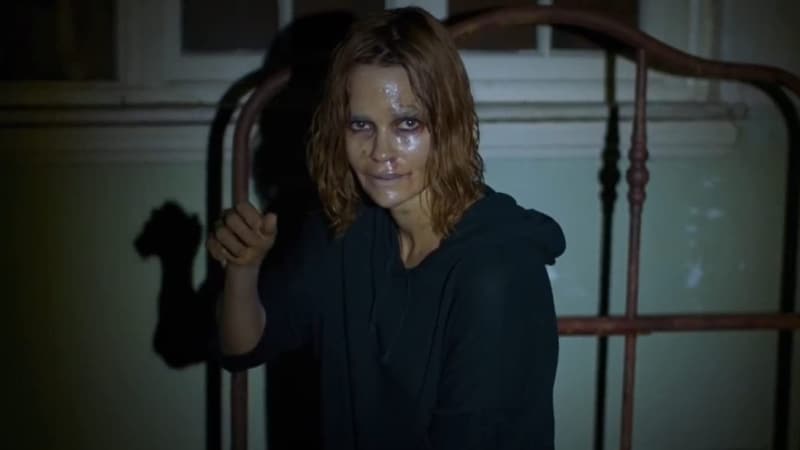
It’s no real surprise to say that Neill Blomkamp‘s strengths as a filmmaker rest almost exclusively in his visuals. From District 9‘s (2009) stunning visual effects on a (relative) budget to the near tangible CG of the otherwise obnoxious Chappie (2015), for all of their narrative weaknesses his films always look pretty damn impressive. His latest continues that trend to a degree, but where his previous three features are big, bright, and populated by CG characters his latest looks inward for a much smaller nightmare. The visuals, though, are once again the strongest takeaway in Demonic.
Carly (Carly Pope) hasn’t seen her mother in years, but that doesn’t stop Angela (Nathalie Boltt) from popping up in her daughter’s nightmares. The latest sees Carly walk in on her mother inside a large sanitarium set remotely amid an overgrown field, but a terror that starts in the dream continues into real life when she discovers that Angela has fallen into a coma. Convicted years prior of a mass murder and left to rot in prison, the woman has been transported to a medical research facility called Therapol. The doctors contact Carly in the hopes of convincing her to enter Angela’s mind via some high-tech VR mumbo jumbo so that she can see what’s up with the comatose woman. What could go wrong?
That’s the cue for everyone who’s seen Dreamscape (1984) and The Cell (2000) to raise their hand…
While saddled with some newfangled bells and whistles, Demonic is ultimately little more than a fairly basic tale of possession. Blomkamp, who also wrote the script, teases some bigger ideas in both the mythology and the response to it, but neither ever come to much of a fruition. Instead, the bulk of the film’s focus is on a slow rollout of expository discovery and a showcase for the relatively new virtual tech called volumetric capture. It creates an undeniably unique look for parts of the film, but “huh” isn’t the ideal takeaway when watching a horror film.
The tech is a form of VR that uses numerous cameras to “capture” a person and then place them in digitally created (or repurposed) environments. It’s a memorable look, and Blomkamp spruces it up with artefacts, intermittent fuzziness, and active builds — we see a memory from Angela’s mind forming before our eyes as Carly moves through it. There’s an unavoidable feeling, though, that this glorified tech demo wasn’t given much thought beyond that.
It should surprise no one to learn that Therapol is hiding something, but a genuinely fun idea is revealed and then utterly wasted. Chalk it up to budgetary concerns or pandemic limitations, but the tease amounts to nothing as Demonic completely skips past the sequences that held the most promise. Again and again we see aftermath only, and it’s disappointing as it’s the only bit of narrative freshness in the film. A bigger, more energetic version of the story would find thrills in those absent set-pieces, but we’re left instead wondering what could have been.
Blomkamp is unable to deliver much in the way of atmosphere or scares in part because VR is the enemy of both. The artificial look immediately lessens the impact of nearly everything that unfolds within, but the filmmaker does find a bit more success outside the simulation. Carly succumbs to visions in the real world as the demonic presence makes itself known, and Blomkamp lets some practical visuals work with net positive results. We may not get too clear a glimpse of the beast itself, but when a friend flips backwards for an Exorcist-inspired spider walk it manages the film’s only chills.
Demonic‘s cast powers through the script without standing out, and while saddled with a fairly rote journey towards an inevitable end, Pope ensures viewers care just enough to keep watching. Terry Chen and Michael J. Rogers feel almost as if they’re in a different movie, but both do good work. The small cast also includes Chris William Martin and Kandyse McClure as Carly’s longtime friends, and their characters suggest there may have been more interesting beats forgotten in the backstory. Boltt is saddled with the toughest role — an evil, haunting figure from the past who may actually be deserving of redemption — but Blomkamp doesn’t give her enough space to earn what instead is merely unloaded via exposition.
What are demonic visions but the devil’s VR? It’s a question worth asking even if Demonic thinks otherwise. The film instead is content pairing new tech with old tropes in the form of a fairly dull journey of uninteresting discovery. There’s a bigger story here, one sitting just off camera in unseen frames and unshot pages, and it’s unfortunately the one Blomkamp has chosen not to tell in favor of playing with new tech and forgetting the flesh and blood beings right in front of him.
Related Topics: Demonic, Neill Blomkamp
